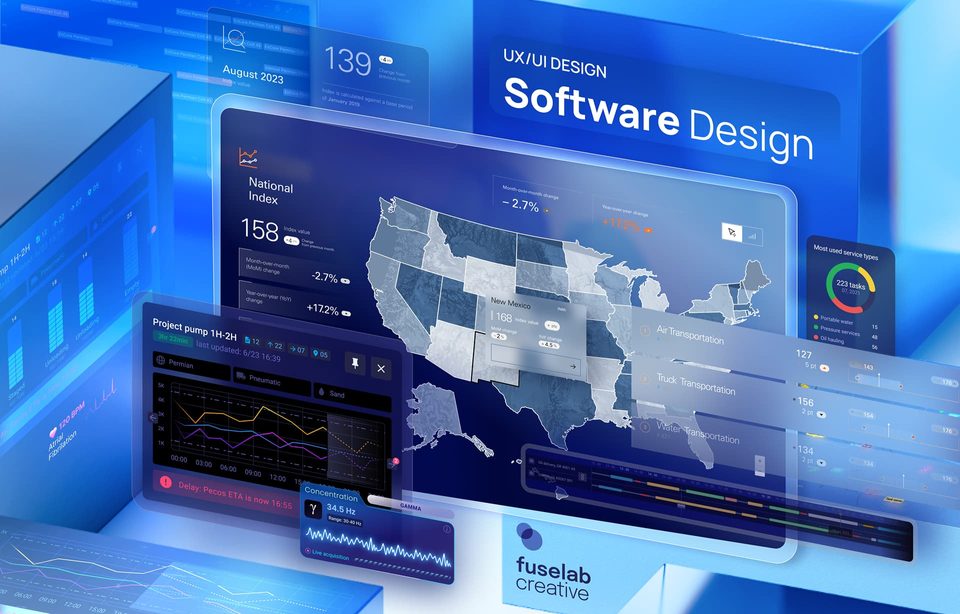Why Your Digital Product Needs a UX Audit

UX Audit for Your Digital Product
To make sure your digital product’s UX is competitive, you need to audit — it’s as simple as that. A UX audit aims to give you insight into what is working within your digital product’s user interface, what is not working, and how the whole setup can be optimized.
It’s not just the user interface you need to be testing. For example, UX content audits can help you ensure that your audience is fully engaging with your content. In contrast, website UX and usability audits ensure that all digital locations across the web represent your brand in the right way.
Let’s take a look at this in more detail as we attempt to understand why your digital product needs a UX audit.
What Is a UX Audit?
A UX audit — sometimes known as a CX audit or customer experience audit, if focused solely on customers — is an analysis and assessment of the current user experience of your digital product. When your audience connects with your product, they need to navigate a series of screens as part of their journey through the user interface. This journey may be very simple, straightforward, intuitive, user-friendly, or any other positive adjective. On the other hand, it may be confusing, slow, illogical, and frustrating. The UX audit provides an in-depth understanding of how your user interface is performing, and where improvements are needed.
Not only this, but the audit will also provide actionable insight into exactly how to improve your user interface. Understanding whether your users are delighted with or distressed by your digital product is just the first step — you and your business need to know how to optimize the overall experience, with a focus on ultimate efficiency.

The Benefits of a UX Audit
Perhaps you have already launched your digital product, and customers are already engaging with it. You might not see a need for a UX audit report as the product is no longer in development and is instead out there in the public sphere. However, this is not the case; this is the mindset of product owners that will soon be left behind. One thing we know for certain, possibly now more than ever, constant improvements are simply a part of the digital product life cycle.
A UX audit is always highly beneficial — simply because the development of your digital product is ongoing. Like with a website redesign audit or any process that examines a digital interface, you need to stay aware of how your customers and users are experiencing the product, how expectations are changing, and if your product is keeping up.
A Broader View of Product Potential and Current Flaws
After spending considerable time and effort developing your digital product, it’s easy to lose perspective. You and your team are so focused on achieving the project targets that you lose sight of the bigger picture. Crucially, you lose sight of how your user’s needs and goals are changing in a competitive environment.
A UX audit helps you to step outside of this narrow view. Rather than getting bogged down in your own experience of the product, you will gain perspective — you will learn more about how your product is performing and areas in which it may be falling short. This is what is meant by a heuristic UX audit — the process of allowing users to explore the interface themselves and provide insight as they go.

A Reliable Roadmap for Product Design and Development
The word “audit” suggests a reactive process, which is true to an extent — when we audit your product, we examine the existing user experience. However, the audit can also be used to decide upon your project’s next steps and determine a positive direction for design and development.
There is no guesswork here. Instead, decisions are made based on available data. This means your teams can make accurate predictions regarding how your users will respond to changes and stay one step ahead of your competitors. In this sense, your UX audit gives you the confidence you need to be innovative and take strategic chances with future improvements.
A Market-Oriented Analysis
We’ve already touched upon your competitors above, so let’s examine this in more detail. You are not alone in your industry and your market. You need to do more than just analyze your products — you need to examine where competitor products fit into the broader market ecosystem.
When we audit your user experience, we will use competitor product UXs as key performance benchmarks. It’s not about ‘copying’ your competitors and trying to operate in the same way they do. Instead, your challenge is to recognize how you measure up against others in your field and ask yourself why would someone choose your product above others, or not.
A Better Understanding of Your Audience and Their Needs
You need a strong understanding of your audience and their needs if you are to develop a successful digital product. You can gain some of this understanding by putting yourself in your audience’s position when you carry out a UX audit. This enables you to think differently about how your product works and how the interface can be improved.
The UX auditing process can do more than this. For example, as part of your audit, we can seek opinions and reviews from third-party testers, offering insights directly from the users themselves. This is an essential step in understanding precisely who your audience members are, where they are coming from, and what they expect from you.
Improved Audience Relationships
By performing a UX audit or calling upon a UX design service, you demonstrate your commitment to providing an excellent experience for your users. This is a big deal in an increasingly competitive marketplace, as it proves that you genuinely care about the journey your customers or users are on.
The experience you provide is vital to your users and your relationships. As many as 97% of customers say they have abandoned an eCommerce cart because the service was not convenient enough. Meanwhile, convenience was cited as the third most important driver of online purchases, behind item quality and price. These examples come from the world of eCommerce, and digital products may operate in very different spheres – however, convenience is still critical to your audience’s relationship with your business. Auditing provides an opportunity to improve this relationship.
Streamlined Development Processes
Auditing provides concrete information regarding user experience. This means there is no need for trial and error during development and no need to go “back to the drawing board” if something has not worked the way you intended.
With the information you gain from your audit, your development projects become much more streamlined and straightforward. In addition, with far fewer steps in each process — and almost complete elimination of false starts and errors — you’ll find the whole procedure becomes much more efficient and cost-effective.
Read also about UX strategy design.
How to Conduct a UX Audit
How to conduct a UX audit? When we audit UX and conduct assessments of a digital product and website usability, we follow a systematic method to achieve the most reliable insight. This method progresses through five UX audit steps or phases, each designed to further refine our understanding of your user experience.
Phase 1: Outlining the Parameters and Targets
The first phase of the UX audit is essentially the planning phase. This is where our UX design agency will identify the metrics you want to target for your audit — basically, what we need to measure during the audit project. We’ll also define the timeline for the auditing process — i.e., the length of time we will spend assessing your interface — and the project’s budget.
With these key aspects defined, we can put together our team. Each member of the auditing team will be responsible for a specific element of the UX and will have a pre-determined role. This enables us to complete the auditing project efficiently, ensuring all areas are covered.

Phase 2: In-depth Data Analysis
The UX audit depends upon data — high-quality data that we will use to assess the experience you are delivering to your users. This data needs to be a mixture of quantitative and qualitative, providing raw figures that we can use to gauge improvement and trends, as well as actionable insights to improve the interface.
Quantitative data generally comes from UX audit tools such as analytics software. These tools monitor the user journey using the usability audit, identifying any points of friction. On the other hand, qualitative data is drawn from interviews with users, test personnel, and stakeholders, allowing us to understand how the interface operates.
Phase 3: Interpreting Data
The audit requires a substantial amount of data. During phase 2, we gathered this data, but now we need to mine insights from this resource. To achieve this, we need to organize and store the datasets.
Digital tools can accelerate the process of interpreting data and identifying patterns. Meanwhile, cloud storage structures ensure that data is retained securely and accessible to all who need to use it.
Phase 4: Developing Data Sets
The data has now all been collected, but we’ll need to refine and develop it before we can turn it into a set of actionable insights. To achieve this, we’ll analyze the data side by side with images taken from the user interface itself, assessing what is working and what needs to be improved. We’ll also cross-reference qualitative and quantitive data to get a more accurate picture of what is going on.
Once phases 4 and 5 are complete, your business will have a formidable resource to refer to and a set of actionable next steps that are ready to be implemented.
Phase 5: Implementing Insights
The final phase of the audit is to make any changes that may have arisen during the analysis. Auditing is about assessing the current state of your user interface and your UX, but it’s also about making practical changes for the future.
Once these changes have been implemented and actioned, ongoing monitoring ensures that they are effective in the long term.
UX Audit Checklist
What about the digital product or website UX audit checklist? What do you need to cover as you go through your audit? This list should provide some idea of how to begin an analysis.
- User profiles – Who is your audience, and what do they want to achieve?
- List of integrations – For example, If your digital products interact with your website, you will need to be aware of this so you can test the holistic user experience.
- Toolkit – The digital tools you will need to analyze and assess the UX (more on these below)
- Key metrics – You will need to know which metrics to measure before you begin.
- Test subjects – Who will be performing test runs and analysis via your user interfaces?
- Audit and implementation timeline – How long will the audit take, and when do you expect to implement your findings?
UX Audit Case Studies: Different Types of UX Audit Processes
We can perform a UX audit in different ways, depending on the type of digital product and the intended outcome. Take a look at a few key UX audit examples;
App UX Audit
Mobile app UX audits are common for businesses that provide software applications to their users. The UX audit for a mobile app hones and refines the user’s journey as they access the different features and aspects of the solution.
SaaS UX Audit
Businesses operating with a software as a service — SaaS — business model need to focus on the experience they offer to users. While the business support team will be on hand to assist SaaS subscribers, these clients still want to enjoy a largely self-serve experience when they connect with this software.
Website User Experience Audit
A web design audit is necessary to ensure the customer journey is a positive one. This is particularly true for eCommerce UX audits that can directly increase revenue.
Accessibility UX Audit
An app or website user experience audit is not just about achieving a slick and streamlined user interface. It’s also about ensuring that all users can access your products, including those with disabilities or impairments.
Design System Audit
You may decide to focus on your design system rather than your finished interface as part of your UX audit. This means you are left with a system of ready-made elements that can be used to craft effective user interfaces and designs in the future.
UX/UI Design Services from Fuselab
At Fuselab, we are serious about user experience, and we offer a range of services designed to help you deliver the very best UX to your audience.
Reach out to our UX design consultants today to discuss your needs, and let’s make that slick user experience a reality.

Browse more

Data Visualization Trends 2024
